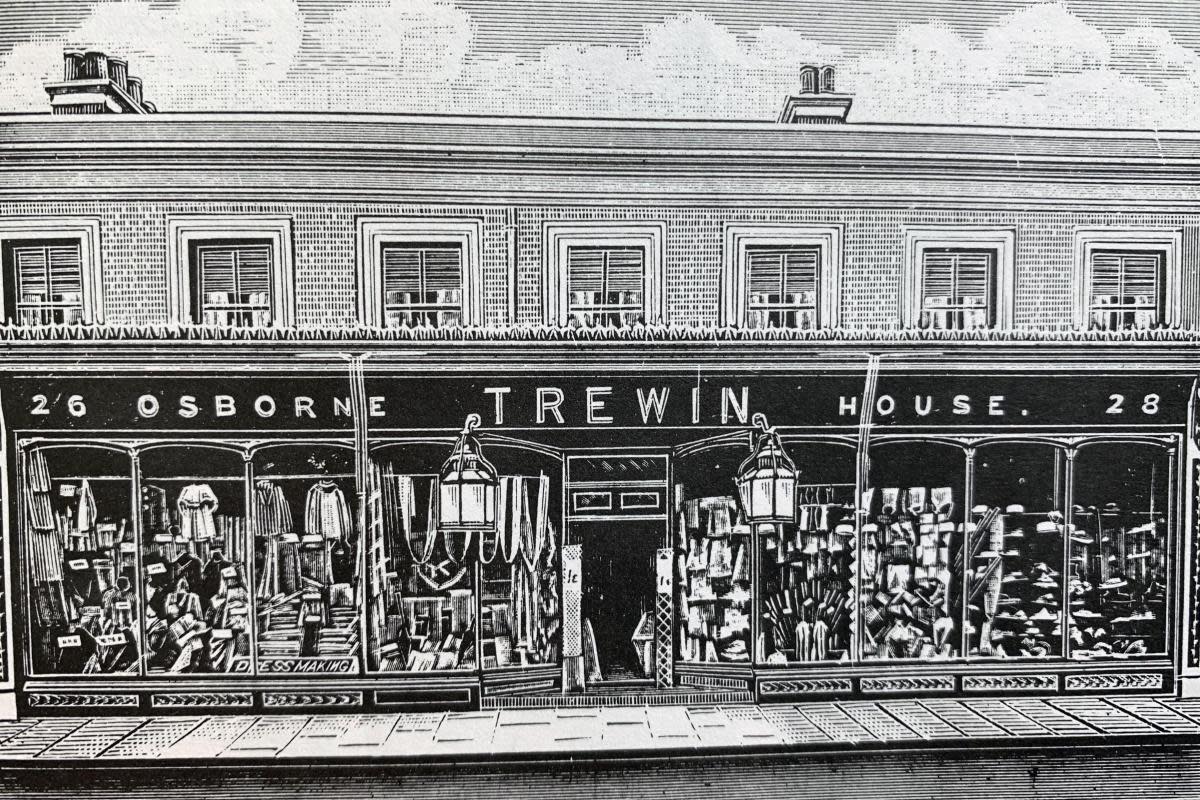The draper's shop that became the Trewins success story

In the 19th century, long before the era of shopping centres, draper Arthur Trewin traded in Queens Road, Watford. His shop was to play a significant role in Watford’s history. It grew into a highly successful business that thrived for 130 years before being purchased and rebranded by the John Lewis Partnership in 2001 and relocated to the Harlequin Centre (now atria).
The ‘Trewins’ tale began in 1880 when Cornishman Arthur Trewin bought a small draper’s shop in Queens Road. Seven years later, he opened the newly-built Osborne House at 26/28 Queens Road, near the Derby Road intersection. Close to the Post Office and the Wesleyan Church across the road, it was a time when Queens Road boasted a wealth of individual traders and a dedicated clientele. The striking frontage measured 54-feet and had large, tastefully-dressed display windows. The roomy interior was well-stocked with several departments that sold goods according to the season.
Arthur Trewin. Image: Watford & Bushey Pictorial Record, 1915
The premises were further extended to 20, 22, 28a and 30 Queens Road, whilst an additional 63 feet by 30 feet development at the rear provided a showroom for costumes and millinery and showrooms for ladies’ outfitting, as well as living accommodation for staff members.
Trewin Bros. extended premises. Image: Watford & Bushey Pictorial Record, 1915
In the early days, the shop specialised in general drapery, millinery and fancy goods, dress and mantle making, ladies’ hosiery, gloves and mourning clothes.
Suitable materials for the latter were stocked and assistants promptly responded to letters or telegrams from ladies living at a distance who wished to make purchases. Dressmaking materials of ‘good lines’ were sold and the proximity to London enabled Arthur Trewin to rapidly adopt new styles and fashions by make or material.
A popular venue for shoppers, he noted ‘it is sufficient to say that every lady in Watford and around knows all about the styles and range of fashions exhibited.’
Trewin Bros. fashion department. Image: Watford & Bushey Pictorial Record, 1915
He sold hats, bonnets, ‘French flowers’ which comprised stiffened silk floral creations for hats, lace and ribbons. Arthur Trewin had a wide experience of the trade and earned a reputation for buying ‘judiciously’ and selling at prices that were not prohibitively high, at the same time ensuring the quality was ‘genuinely good’. His was a ‘medium price trade’.
He was an active member of the local Urban District Council, a ‘prominent worker’ in the Wesleyan Church nearby and respected for his personal and business qualities. By 1915, his brother Henry, a member of the local Board of Guardians and a special constable, joined the business. The renamed Trewin Bros. extended its departments beyond drapery, millinery, dressmaking, ladies’ and children’s outfitting to include soft furnishings, cabinets, carpets, upholstery and blinds and toys, which the shop continued selling into the 21st century.
Around the time of World War One, Trewin Bros. opened a welcoming Grotto Tea Room in the basement. The room was reportedly cooled by the pools at the base of the blocks of the coloured concrete with which it was built.
Trewin Bros. Grotto Tea Room. Image: Watford & Bushey Pictorial Record, 1915
Fast forward to the interwar years, specifically February 1, 1927, when Benjamin Drage, owner of Drages Ltd., a Birmingham furniture shop, successfully achieved a revolutionary method of selling new furniture to the working classes via consumer credit. He advertised his furniture nationally and, by default, his social reforms. Trewin Bros. realised the benefits and adopted the no deposit system for furniture and household utensils, with ‘the most generous terms and outstanding values ever offered.’ Its advertisement was revealing: ‘The wonderful no deposit system of home furnishing. These very words will conjure up in the imagination a picture of absolute shopping freedom under conditions that inspire a confidence as unshakable as the very foundations of the great pyramids of Egypt.’ Excitement indeed! There would be 36 equal payments; the first secure delivery.
Henry Trewin. Image: Watford & Bushey Pictorial Record, 1915
Trewin Bros. went further and extended the offer to perambulators, or rather prams, selling the most reliable makes at Watford’s lowest prices. Bicycles were included, specifically the Selfridge cycle – ‘a no trouble mount’. Yes, there was a Selfridge connection. In 1918 the business had been sold to American Gordon Selfridge and operated as one of a number of provincial stores until l940.
My memories of ‘Trewins’ include its winding stairs and creaky floors, its quaint ambience and the quirky layout of the Victorian/Edwardian building. The spacious upper floor was filled with designer fashion labels, with prices beyond my young pocket. In later years, when I eventually tried on clothes in one of the dressing rooms, I found mirrors on opposite sides so I wasn’t left wondering what a garment looked like from behind! For me and many others, ‘Trewins’ was synonymous with courtesy and reliability. Along with so much of old Watford, ‘Trewins’ is now relegated to the history books.
It was a sad day when the closure of John Lewis, which had taken over the business less than 20 years earlier, was announced during the pandemic in 2020.
Lesley Dunlop is the daughter of the late Ted Parrish, a well-known local historian and documentary filmmaker. He wrote 96 nostalgic articles for the ‘Evening Post-Echo’ in 1982-83 which have since been published in ‘Echoes of Old Watford, Bushey & Oxhey’, available at www.pastdayspublishing.com and Bushey Museum. Lesley is currently working on ‘Two Lives, Two World Wars’, a companion volume that explores her father’s and grandfather’s lives and war experiences, in which Watford, Bushey and Oxhey’s history will take to the stage once again.

 Yahoo News
Yahoo News 
